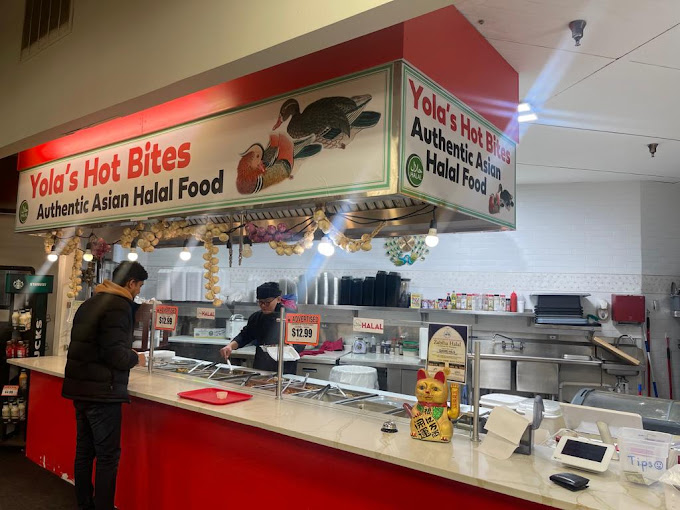Savor Genuine Eastern Cuisine With a Pan-Asian Twist for a Culinary Journey
Starting a culinary journey with genuine Eastern food, enhanced with a Pan-Asian twist, offers a distinct possibility to discover the rich tapestry of flavors that specify the region's varied culinary traditions. This experience invites you to savor the elegant equilibrium of preferences-- pleasant, salted, spicy, and sour-- harmonized by fragrant natural herbs and seasonings. Imagine the innovative fusion of Thai curry and ramen or the unexpected delight of sushi burritos. As you ponder these enticing recipes, take into consideration the social stories and historic influences that shape them, each bite providing a story waiting to be discovered.

Discovering Pan-Asian Tastes
In the world of international gastronomy, Pan-Asian cuisine sticks out for its amazing diversity and the unified interaction of flavors from numerous Oriental societies. This culinary strategy celebrates the special ingredients and rich traditions discovered throughout the continent, creating a tapestry of preferences that is both satisfying and interesting. Key to Pan-Asian cuisine is its capacity to balance different flavors-- wonderful, salted, spicy, and sour-- while highlighting the freshness and high quality of each active ingredient.
From the umami-rich soy sauce of Japan to the fiery chili peppers of Thailand, Pan-Asian cuisine supplies a substantial scheme of flavors. These aspects are usually combined in innovative means, boosting dishes with layers of complexity. For example, the use of fragrant herbs such as lemongrass and cilantro, typical in Vietnamese and Thai food, includes a refreshing brightness to meals, while the unification of coconut milk delivers a creamy, rich structure.
The focus on fresh fruit and vegetables and aromatic spices makes sure that each dish is not only a feast for the taste but also for the senses. Pan-Asian cuisine welcomes diners to embark on a cooking journey, discovering the huge and differed landscapes of Oriental gastronomy with every bite.
Combination Meals to Try
While Pan-Asian food is celebrated for its typical flavors, the modern-day culinary landscape is increasingly accepting fusion meals that blend these traditional components with influences from other areas. This innovative strategy not only honors the abundant heritage of Asian culinary arts yet likewise presents novel taste experiences that interest contemporary tastes.
An archetype of such a combination dish is the Korean-Mexican taco, where marinaded bulgogi beef is covered in a warm tortilla, covered with kimchi and a spicy gochujang-infused salsa. This combination marries the vibrant, tasty tastes of Korea with the dynamic, fresh components of Mexican food. Similarly, sushi burritos have actually gained popularity, integrating the fragile artistry of Japanese sushi with the hearty, hand-held ease of a burrito, usually featuring combination active ingredients like tempura shrimp and avocado with a drizzle of wasabi mayo.
Another notable meal is Thai curry ramen, which instills the creamy, aromatic spices of Thai curry right into the reassuring brew of conventional Japanese ramen, producing a harmonious mix that tantalizes the senses. These blend recipes expand beyond mere novelty; they represent a cooking discussion in between societies, encouraging exploration and innovation in the globe of Pan-Asian food.
Vital Components and Flavors
To really appreciate Pan-Asian cuisine, one must understand the important ingredients and flavors that develop its foundation. This diverse cooking style draws from an abundant tapestry of Eastern customs, employing a harmonious mix of appearances and flavors.
Aromatic components are essential, with ginger, garlic, and lemongrass being ubiquitous throughout different Pan-Asian recipes. These active ingredients offer a fragrant base that boosts the complexity of tastes. Flavors such as celebrity anise, cardamom, and cinnamon introduce heat and personality, echoing impacts from regions like China and India.

Food Preparation Strategies and Tips
Mastering the art of Pan-Asian cuisine needs knowledge with its distinctive cooking methods, each adding to the vibrant tapestry of flavors this culinary custom is commemorated for. Central to these approaches is the stir-fry, a rapid cooking technique that protects the nutritional honesty and dazzling shades of ingredients. Utilizing a wok, the stir-fry technique enables for also warmth circulation, crucial for achieving the characteristic structure and flavor balance of Pan-Asian meals.
One more essential method is steaming, specifically widespread in Chinese food. This mild technique keeps the all-natural tastes and nutrients of active ingredients, making it ideal for seafood and vegetables. Dumplings, a beloved staple, typically take advantage of steaming, leading to soft, delicious structures.
Cooking, additionally indispensable, gives great smoky depths to dishes such as Korean bulgogi or Japanese yakitori (pan asian restaurant Islamabad). This technique frequently involves marinating active ingredients, permitting tastes to permeate deeply prior to cooking over an open flame or warmer
Last but not least, grasping the art of balancing flavors-- pleasant, sour, salty, bitter, and umami-- is vital. Appropriately layering these aspects can raise a dish from average to extraordinary, using a complicated and satisfying cooking experience that symbolizes the essence of Pan-Asian food.
Dining Experiences Worldwide
Around the world, Pan-Asian cuisine supplies an unmatched eating experience, celebrated for its abundant tapestry of flavors and lively presentations. This cooking phenomenon has actually transcended cultural limits, capturing the hearts and tastes of food enthusiasts worldwide. In worldwide cities like New York, London, and Sydney, Pan-Asian dining establishments serve as fusions where culinary practices from Thailand, Japan, China, and beyond assemble, offering restaurants with an eclectic mix of recipes that highlight the region's variety.
The worldwide charm of Pan-Asian food depends on its ability to use both credibility and innovation. Chefs skillfully marry standard active ingredients such as lemongrass, soy sauce, and miso with modern techniques, resulting in dishes that are both refreshingly brand-new and acquainted. This fusion enables diners to start a cooking trip that values heritage while welcoming modernity.
Moreover, eating experiences are elevated through attentively created atmospheres that mirror the ethos of Pan-Asian looks. From minimal Japanese-inspired interiors to lively Thai-themed spaces, each restaurant uses a special atmosphere that enhances the cooking offerings. Therefore, customers are not simply consuming a meal yet partaking in a social experience, making Pan-Asian dining a genuinely worldwide phenomenon.
Conclusion
The expedition of Pan-Asian food provides a profound understanding of the intricate interplay of tastes and cooking customs across Asia. By embracing blend meals such as Thai curry ramen and sushi burritos, the useful site culinary trip not just highlights the versatility of conventional ingredients but additionally showcases ingenious contemporary methods. This gastronomic adventure, improved by crucial flavors and cooking methods, provides an one-of-a-kind possibility to appreciate the social diversity and culinary virtuosity that define Pan-Asian food on a worldwide range.
Getting started on a cooking journey via authentic Eastern cuisine, boosted with a Pan-Asian twist, supplies a special opportunity to check out the abundant tapestry of flavors that specify the area's diverse culinary customs.In the world of international gastronomy, Pan-Asian food nearest kfc stands out for its remarkable variety and the harmonious interplay of tastes from various Oriental societies. Secret to Pan-Asian food is its ability to balance different tastes-- sweet, salted, spicy, and sour-- while highlighting the quality and quality of each component.
